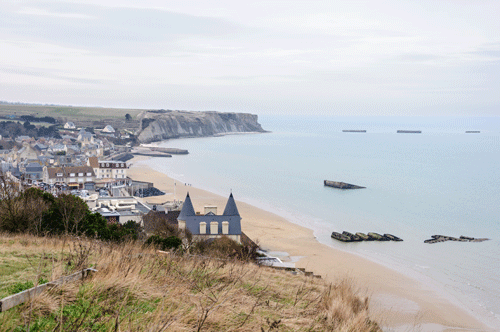
The Village of Arromanches showing remaining sunken concrete barges from the World War II Mulberry Harbor
This past year, I was privileged to accompany my Father on a trip to the Normandy area of Northern France. The area is famous in history as the site for the D-Day Landings during World War II. The D-Day landings were the amphibious operations on June 6, 1944 of the Allied invasion of Normandy. The landings were the largest in history and began the liberation of occupied Europe from German control and eventually resulted in the Allied victory over Nazi Germany.
Previously in Part 1, as found in last month’s issue, I wrote about our visit to the La Cambe German war cemetery, Sainte-Mère-Église, Utah Beach, and Carentan.
Pointe du Hoc was the first stop of our second day in Normandy. Pointe du Hoc was a high point of land with cliffs facing the water between Utah Beach and Omaha Beach. Starting in 1943, the German Army had fortified the Pointe du Hoc area with concrete bunkers and gun pits. Six 155mm guns and other weapons were positioned in the fortifications. The 155mm guns could have easily reached both the Omaha and Utah Beach landing areas. U.S. Army Rangers under the command of James Earl Rudder were given the task of capturing Pointe du Hoc. Among the support vessels for the operation was the Battleship USS Texas.
Early on the morning of D-Day, the landing craft carrying the Rangers approached the cliffs of Point du Hoc. Among their equipment were rocket propelled grappling hooks with ropes and a few 100-foot long ladders requisitioned from the London Fire Brigade. The assault was very costly, with the Germans firing on the Rangers as they climbed up the ladders and ropes against the sides of the cliffs. After the Rangers took Pointe Du Hoc, they made the shocking discovery that the 155mm guns had been previously removed from their mountings and moved further inland by the Germans after pre-invasion bombings. The six guns were later discovered by the Rangers and disabled. By the end of the day, only 90 out of the original force of 225 Rangers remained able to fight.
Pointe du Hoc was preserved after the war and was transferred to U.S. control. Today the American Battle Monuments Commission is responsible for its upkeep. Heavy damage can be seen on the remaining German fortifications. The area is also pockmarked with deep craters from aircraft bombs and the USS Texas 14” fourteen inch guns. Entryways to the various bunkers are marked with bullet holes and grenade damage. On top of the German command bunker is a monument to the Rangers that was dedicated by President Ronald Reagan on June 6, 1984. To my surprise, I saw a plaque with a State of Texas Seal bolted to the inside of the Command Bunker. It commemorates James Earl Rudder, the native Texan who led the Pointe du Hoc assault. Rudder was a high school football coach and teacher before the war. After the war, he served as Mayor of Brady Texas, Texas Land Commissioner, and then President of Texas A&M from 1959 until his death in 1970.
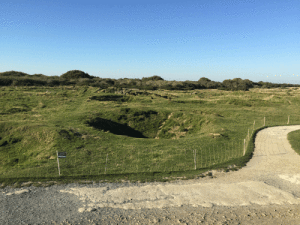
Craters today at Point du Hoc
Our second stop of the day was Omaha Beach. The five amphibious landing beaches were codenamed East to West; Utah, Omaha, Gold, Juno, and Sword. U.S. Troops would land at Utah and Omaha Beaches, while British, Canadian, and Free French Troops would land at Gold, Juno, and Sword Beaches. The primary objective at Omaha beach was to secure a beachhead between the British landings at Gold Beach to the east, and the U.S. forces landing at Utah Beach to the West. The amphibious assault was to be carried out by the 1st Infantry Division, 29th Infantry Division, and Army Rangers. The soldiers landed under heavy fire from gun positions in the bluffs overlooking the beach. The landing areas were also mined and covered with obstacles.
Very little went as planned during the landings at Omaha Beach, navigation errors caused many of the landing craft to miss their assigned landing areas. Many of the amphibious Sherman tanks launched offshore were swamped by the waves and sank. The German defenses were unexpectedly strong, inflicting heavy casualties on landing U.S. troops. Under heavy gunfire, army engineers struggled to clear the beach obstacles while the exposed troops on the beach suffered many casualties. A total of 2,499 U.S. soldiers were killed on D-Day at Omaha Beach.
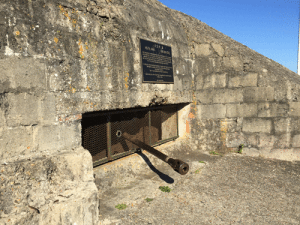
German WN65 bunker on Omaha Beach with 50mm gun
Omaha Beach today is built-up with houses, roads, and a seawall. I even saw a beachfront house built using a concrete bunker as its foundation. A few intact German bunkers and gun positions can still be seen in the bluffs. One German Bunker with its 50mm gun is preserved as a tourist attraction. Designated as WN65 by the Germans, this bunker caused many casualties among U.S. troops until finally being taken out and captured around noon on D-Day.
The Overlord Museum in Colleville-sur-Mer contained excellent artifacts & displays from the Omaha Beach landings, as well as relics found over the years in the beach area. Another stop was a small museum in Port-en-Bessin containing amphibious tanks and other equipment salvaged from the ocean near the landing areas over the years.
The Normandy American Cemetery was our next stop; it is located on a bluff overlooking Omaha Beach. The Cemetery is also under the control of the American Battle Monuments Commission, covers 172 acres, and contains the graves of 9,387 U.S. military personnel. Those buried there include 307 unidentified U.S. Soldiers, three Medal of Honor recipients, four women, 33 pairs of brothers, and a father and son. After the war, the next of kin was asked if they wanted their identified loved ones brought back for burial in the U.S. or remain buried in France. The marble crosses marking the graves of unknown soldiers are marked: “HERE RESTS IN HONORED GLORY A COMRADE IN ARMS KNOWN BUT TO GOD”. It is a very beautiful and somber place that makes one appreciate the sacrifices our troops made to liberate Europe. 1,557 U.S. personnel remain missing or unidentified in the Normandy Area and remains of soldiers continue to be found in the area to this day.
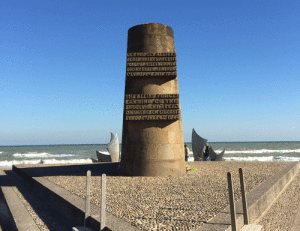
Monument at Omaha Beach
One notable burial at the Normandy American Cemetery is Theodore Roosevelt Jr, eldest son of President Theodore Roosevelt. A World War I veteran, he was given command of U.S. troops landing at Utah Beach. Roosevelt was the only general on D-Day to land with the first wave of troops. At the age of 56, he was also the oldest U.S. soldier in the invasion. His son Captain Quentin Roosevelt II was among the first wave of soldiers to land at nearby Omaha beach. Walking with the aid of a cane and carrying a pistol, Theodore Roosevelt Jr personally made a reconnaissance of the area around Utah Beach to coordinate the attack on the German positions, Roosevelt’s famous words on D-Day were; “We’ll start the war from right here”. On July 12, 1944, a little over a month after the D-Day landings, Roosevelt died of a heart attack near Sainte-Mère-Église in Normandy. Some years after the war was over, General Omar Bradley was asked to name the single most heroic action he had ever seen in combat. His reply was; “Ted Roosevelt on Utah Beach.”
The small beachfront village of Arromanches was the last stop of our second and final day in Normandy. Arromanches was in the Gold Beach landing area on D-Day and was important as one of the two sites for the artificial harbors the Allies built to hurriedly offload supplies and troops for the invasion effort. The British built huge floating concrete barges that were sunk to provide an artificial harbor. These pre-fabricated harbors were known as Mulberry Harbors. The Arromanches Mulberry Harbor was in service by June 12, 1944, a mere six days after the D-Day landings. During its 100 or so days of operation, the harbor landed 2.5 million men, 500,000 vehicles, and 4 million tons of supplies. Today, Arromanches is mainly a tourist town. The sunken concrete barges from the Mulberry Harbor can still be seen in the waters around the town.
Our visit to the D-Day towns, beaches and cemeteries in Normandy taught me a lot about World War II history that I didn’t know. I am thankful that I was given the opportunity to go with my Father, Elmer DeForest, to see these sights.
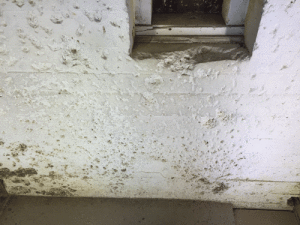
Pointe-du-Hoc bullet holes
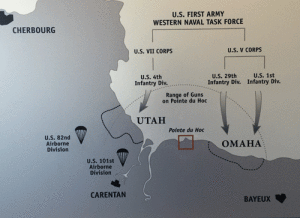
Map showing Utah Beach, Pointe du Hoc, and Omaha Beach
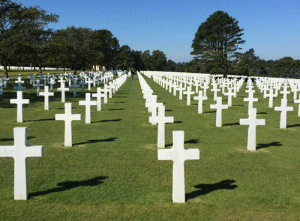
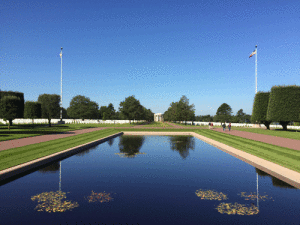
Normandy American Cemetery
